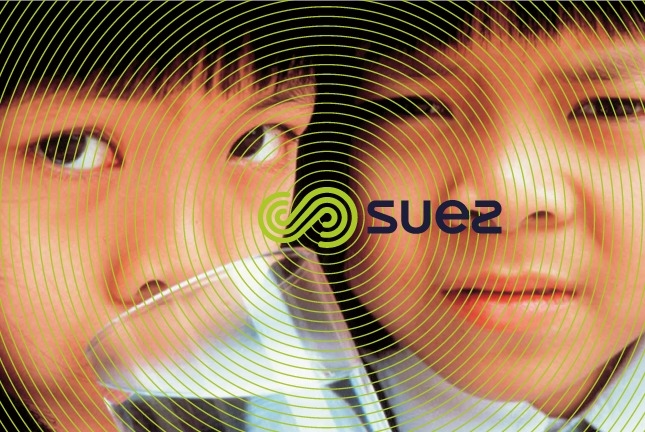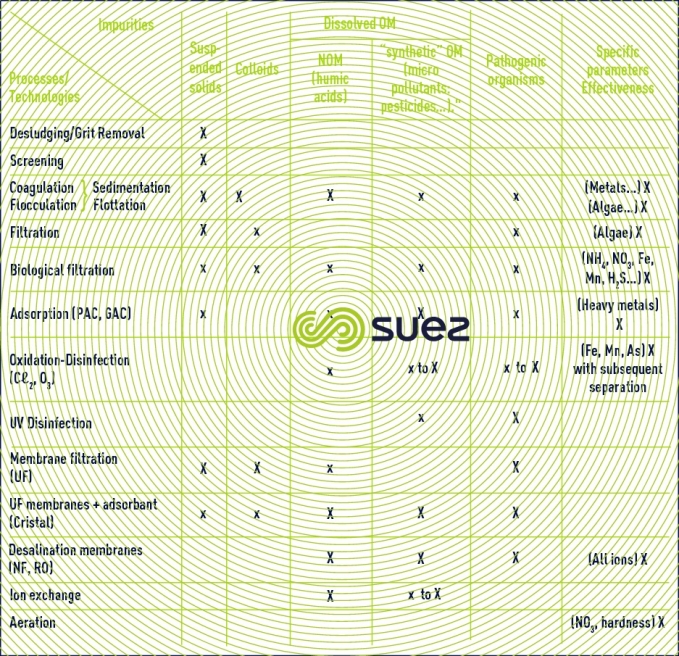drinking water treatment



introduction
The object of this chapter is to show how "treatment train" arrangements combining a range of technologies can be used to process the most difficult fresh water source to render it potable, bearing in mind that brackish water or seawater desalination was reviewed in the section desalination membrane application.
The reader is invited to refer to chapters fundamental physical-chemical engineering processes applicable to water treatment and fundamental biological engineering processes applicable to water treatment for an outline of the theoretical principles pertaining to the physical-chemical and biological treatment processes utilised and also to the chapters describing the various degremont® technologies, in particular: see chapters flocculators – settling tanks – flotation units, filters, separation by membranes and oxidation-disinfection.
Typically, the available freshwater resources are distinguished by three major categories (see chapter what water should we treat ? and why ?):
- surface water: this category of water is frequently described by the degree and type of suspended solids (including organic materials, colloidal particles, and algae concentrations that are subject to rapid variation); dissolved organic matter (natural or artificial, color); pathogenic organisms (viruses, bacteria, protozoan parasites…) and sometimes particular minerals such as heavy metals;
- deep groundwater, on the other hand, normally contains no suspended solids, pathogenic organisms nor ( OM ) other than NOM; however, groundwater frequently contains reduced compounds such as Fe(II), Mn(II), NH4… and even toxic minerals such as As, Se, F…, radioactive elements, or groundwater sources may simply be too hard or soft, too saline (Cℓ–, SO42–), or contain too many nitrates. It should be noted that each of these elements require specialised treatment strategies unlike surface water sources, which typically call for a more generalised treatment approach (clarification, polishing, disinfection), resulting in the general layout of this chapter;
- groundwater “under the influence of surface water”, intermediate amongst the first two categories, this group includes very shallow groundwater sources, water in karstic systems…, and is often clear but susceptible to rapid deterioration from turbidity and all the other contaminants found in surface waters and deep groundwater sources.
Note: a fourth category can also be identified: wastewater recycled for human consumption, usually indirectly (injected into aquifers, into water reservoirs to be processed into drinking water…), bearing in mind that this type of water contains certain pollutants from categories 1 and 2 and that synthetic pollutants play a very important role. One also needs to recall that the main treatments applicable to this category of water tend to be those described in chapters biological processes, treatment and conditioning of industrial water and separation by membranes.
Therefore, to render water potable, there exists an entire range of technologies of which practically none are truly specific to any of the pollutant types referred to above. This is illustrated by table 1 where the X’s denote the processes thatplay a major role in the elimination of a particular type of contaminant and where x’s denote a process that contributes to said elimination but as a secondary property.



As already emphasised, the processes and technologies outlined in table 1 vary widely in terms of cost (capital investment and operational) as well as operating limitations and performance. Consequently, defining an optimum treatment train continues to form part of the “craft” of the Design Engineer with many examples highlighted in this chapter.
Note: although residuals handling (sludge, saturated adsorbants, membrane backwash waste…), with or without preliminary treatment, is not covered in detail within this chapter, it remains an integral component of the overall cost and must therefore be considered when selecting the optimal treatment design.
This table highlights the noteworthy effectiveness of clarification and/or desalination membranes, explaining the increasing tendency of water treatment specialists to recommend them either to replace conventional treatment strategies(filtration of karstic water, disinfection), or to supplement conventional treatment as part of a more advanced system to process more heavily contaminated water.
Depending on the properties of the water to be treated and the effectiveness of a given process, the water specialist will thus be able to group each elementary “stage” into what is commonly referred as a “treatment system”.
Bookmark tool
Click on the bookmark tool, highlight the last read paragraph to continue your reading later












